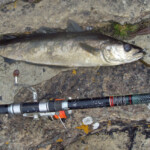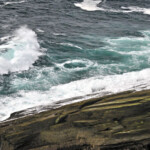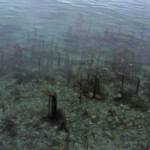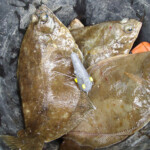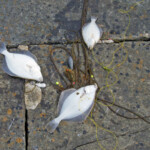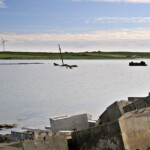Welsh angler John Mason visits Orkney in the north of Scotland where he discovers a world of untapped fishing.
About 395 million years ago what is now Northern Scotland lay close to the Equator. Low, rolling hills separated a series of large freshwater lakes teeming with fish. Every now and then – perhaps seasonally – rainwater swept sand, silt and mud into the lakes, building up layer upon layer of sediment and desert sand dunes spread over the area. In time, the layers of sediment solidified into rocks that were later on tilted by earth movements. The end product of all of these geological goings on, after millennia of erosion, was the Orkney Islands, world famous for their fish, both ancient and modern!
Continuing briefly on the geological theme, for it is directly responsible for the types of shore fishing marks you will find around the islands, we skip forward to just ten thousand years ago, at the end of the last ice age. This produced large volumes of ice melt adding to the volume of the ocean. Before the ice caps melted, the Orkneys consisted of one large landmass. By the time the icecaps had disappeared, the sea level had risen some forty five metres, drowning parts of the landscape and splitting the islands into their current day configuration.

As a consequence of these events, the visiting shore angler finds two key environments to tackle: deep water rock marks where the tilted strata slope down into the sea and extensive, shallow, weed-fringed sandy bays. Here and there, manmade structures jut out into or span the bays, to add a bit of modification to the general picture.
The arranging of a family holiday on Orkney at the beginning of June 2010 provided a good excuse to explore some of the marks with a view to investigating the range of species available, although it was a bit early in the season – the best fishing seems to be late summer through autumn. So I loaded up the car with gear until the axles creaked and headed off on the long road north from Mid-Wales, to board the vehicle ferry that runs daily from Scrabster over to the port of Stromness on the largest of the islands, Mainland.
Short hop to Orkney
Scrabster itself deserves a mention in passing. With an hour to kill before ferry check-in, I parked up and after a ten minute walk was setting up on the rocks immediately below the lighthouse. Here, kelp-fringed rock gave way to clean ground in a good depth of water. I fished 3-hook flapper and 2 up-1 down rigs with size 1 Aberdeens and plenty of bling, baited with salted Welsh black lug and Aberdyfi mussels, the only bait I had brought with me from home. The first bite came while I was setting up the second rod and after just an hour I had taken fourteen good dabs, some over a pound, keeping a few to ensure a good family feast the following evening. That’s one of the most prolific marks I have fished for dabs in terms of quality fish – highly recommended when you are waiting for the boat.
Getting bait was the order of the day at the start of the adventure and a bit of research led me to William Shearer’s shop in Kirkwall (71 Victoria St; Tel: 01856 873189). This is a shop that sells a wide range of stuff from food to gardening and agricultural supplies and tackle but most importantly for me, bait – namely a range of Baitbox frozen products including mackerel, squid, black lug, crab, sandeel. I found another tackle shop – Sinclairs in Stromness (27 John Street; 01856 851523) – that has a large range of gear including enough pirks to decorate a wreck like a christmas-tree, but for bait Shearer’s seems to be the only option outside of chancing it at supermarkets. Indeed, my thanks are due to Sinclair’s helpful staff for putting me onto Shearer’s in the first place! I should add that the shallow sandy bays are packed with blow-lug casts and there are areas of mussels in places for those with the time to gather their own.
Piers of plenty
Next, a bit of a recce saw me trying some of the piers around Stromness and Kirkwall. Typically, you are fishing in 5-10m of crystal-clear water onto sand and stony patches with clumps of eel-grass and kelp. Now, back home in Wales, all piers and jetties carry their compliment of mini species close in around the structures, so the tactic was to bang one rig well out and drop the other close in, with size 6 or smaller hooks baited with bits of mackerel, lug and mussel. On my usual marks that would result in plenty of rattles from small wrasse, blennies, gobies, sand-smelt, poorcod and so on. Here, the baits were coming back untouched! That was a bit of a surprise. Meanwhile, out on the sand, the black lug, mussel and mackerel was attracting a steady stream of flounders, dark-backed fish the colour of plain chocolate, interspersed with the odd dab. And this pattern repeated itself from mark to mark.

The weather was forecast to be dry for much of the next day so instead of flattie bashing, I decided to try some hardcore rock-fishing at Hoxa Head on South Ronaldsay. Here was a typical Orkney rock mark, consisting of those aforementioned slabs of sandstone dipping seaward into gin-clear water 20m or moredeep. Arriving at low water I set up on the slabs, but as soon as the flood kicked in then a swell got up. It’s amazing how far up a seaward tilted slab even a moderate swell will reach and I soon moved to a higher platform, concerned about myself and my gear. This configuration of sloping rock and swell is a frequent feature of Orkney rock-marks and a cautious approach is recommended!
Baits or lures, the choice is yours
The fishing was not dissimilar to that at some of my favourite rock marks in North Wales. I started with feathers and straight away single mackerel, small pollack and coalfish to about a pound began to come in. I then switched to rough ground, single-hook rigs baited with mackerel and lug/mussel to see what was about on the bottom in amongst the rock and kelp. Again, the wrasse and other minis seemed absent but good sized dark coloured dogfish were taking the mackerel fillets, sent out there with the hope of a huss or even a ling.
Towards high water I switched to seeking out some better pollack, tackling up with my usual ‘Bardsey Sound’ rig – a 6-inch ‘natural sandeel’ Slug-Go soft lure, rigged with Texposer-style hooks, on 3ft of 30lb clear Amnesia with a 3oz drilled bullet behind the trace swivel as a casting weight. After just a couple of casts, I had a savage take right at the water’s edge and a two-and-fro scrap ensued as the fish dived into the kelp, then came out into open water just as a larger than usual swell swept it up the slabs and into a chasm. It was too dangerous to climb down to it but keeping steady pressure on the rod as the next wave rolled in had it freed and up onto my ledge where it was swiftly dispatched for supper.


With conditions getting a bit rougher, making landing and returning fish increasingly difficult, with the larder full in terms of fish suppers, and rain threatening, I decided it was pub-time. In better conditions and in the peak of the season this mark and others like it must offer superb sport!
The Churchill Barriers
The next full-day session was at the middle of the second of the Churchill Barriers. These blockwork structures carry road causeways linking the southern islands. Along with the nearby, deliberately sunken Blockships, they were created in World War 2 in order to prevent U-boat access via the narrow but deep sounds between the islands into the sheltered anchorage of Scapa Flow, where U-47 torpedoed the battleship HMS Royal Oak on 14th October 1939 with the loss of 833 lives. Italian POWs assisted with much of the construction.

Scrambling down among the huge concrete blocks to a comfortable spot on the western side of the barrier, I was struck by the similarity of the ground to that at the big Welsh breakwaters of Holyhead and Fishguard, where baits dropped straight down among the blocks produce all sorts of mini species and bigger fish. Several hours later, I was left to ponder on what I was doing wrong! Baits were coming back untouched, both close in and further out. Perhaps the exceptional water clarity was an issue, as I had noted from online articles that night fishing is recommended here, although back home the best conditions for minis are clear water and bright sunshine. Or perhaps there was so much natural food about that my frozen baits were not of interest. Few people will stop at a kebab shop after a four course dinner at a top restaurant! Or maybe it was just that I was there too early in the season. Plenty of good fish are caught here at the right time of year.
On my way back to HQ I checked out the Bay of Skaill, one of a small number of west-facing Atlantic surf beaches. The winter storms had left the surf full of weed which was over a foot deep on parts of the beach, but in better conditions this looked to be well worth fishing – not only for flatties but possibly bass which are caught of the surf beaches on the North Scottish Mainland. One to try next time.
A stiff Northerly dominated the rest of my stay but it gave the opportunity to have some walks with the family along other parts of the west coast, casting a beady eye over countless slabby rock stances dipping down into deep, clear water. Again, the feeling was of tremendous potential in the right conditions, especially around the Brough of Birsay, where countless terns, puffins and other seabirds were flying past, beaks draped with sandeels. If you want to combine fishing with birdwatching, Orkney has to be right up there on the list of venues to visit.
Last knockings
The final afternoon saw a steep, short chop on the inlet by Stromness and a force 6 wind, so I drove round to Ness Point where the inlet meets the Sound of Hoy. Here it was possible to fish out of the car and sort out the tackle that after a few days had inevitably become a little mixed up. Locals catch sea trout here at certain times of year fishing belly strips of mackerel under a bubble float, something I tried without success as the wind repeatedly took my rig around into the shallow, weedy ground to my right. I switched to my flattie rig to finish off the session and was back into the flounders straight away on lug, mussel and mackerel, the final cast of the week bringing a triple shot and a mass of weed!
My general thoughts? Tremendous potential with a lot of marks that are rarely if ever fished. I’d like to go back there in late summer or early autumn, waiting for a huge high-pressure anticyclone to be slap-bang over the islands for a week and no big lows way out west to generate swells. I’d then explore as many deep-water rock marks as possible. I’d also make a point of fishing the Barriers on a night-tide (in mid-June it barely gets dark at all)!
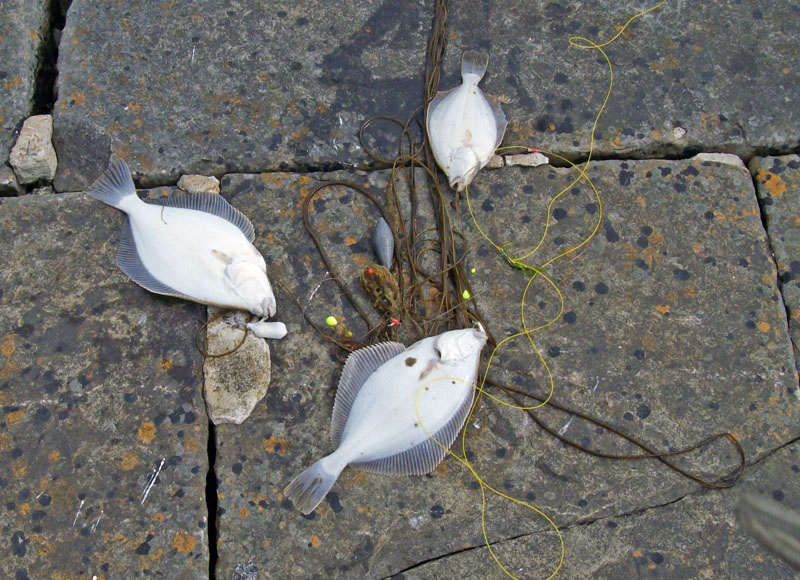
What to bring? Well, the standard shore gear I use on Welsh surf-beaches, breakwaters and rock ledges did me fine. Away from the rock marks and the Barriers, I lost no tackle to snags at all. Rock anglers will combine lure-fishing with legering single hook rotten bottom rigs as standard fare. Take warm clothing with you – these islands are a long way north, temperatures are often several degrees lower as a consequence and it’s breezy a lot of the time. Outside of the fishing, the Neolithic remains are fascinating, the scenery is beautiful, it’s an incredibly friendly place, the pubs are great and the food is superb. It was a shame to have to come away from there.
John’s main site: www.geologywales.co.uk
John’s storm-photography site: www.geologywales.co.uk/storms

